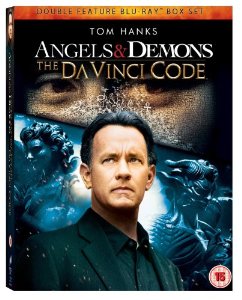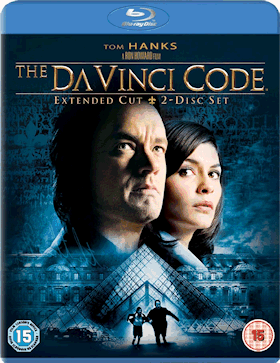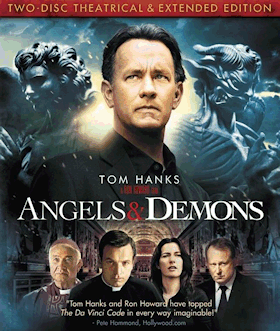
As of 2014, bestselling author Dan Brown has seen two of his books turned into successful Hollywood
productions by director Ron Howard; the first being The Da Vinci Code in 2006, followed by Angels & Demons in 2009. Both films feature symbologist Robert Langdon following clues, cracking codes and unravelling various mysteries in equal
measure. The two films both opened at the number one position at the US box office, and together earned a combined total of more than $1.2 billion worldwide. Each of them was edited to satisfy the MPAA to obtain a PG-13 rating in the United States, and
as is usually the norm with Hollywood films, these PG-13 versions would go on to be the standard versions exported to territories throughout the world.
|
|
Director Ron Howard successfully decoding the secrets of box office success |
Across the Atlantic, however, both films would go on receive further changes in order to receive a 12A certificate in the United Kingdom. In this special edition of Cutting Edge, we'll be looking at the somewhat complicated history of Robert Langdon's
first two adventures at the hands of the BBFC, and making our own discoveries as we seek to uncover what exactly was cut for which versions of the films. It is a journey filled with mysteries all of its own...
The Da Vinci Code and the convoluted path to a BBFC cinema rating
Prior to its theatrical release on May 19th 2006, The Da Vinci Code was causing a bit of a stir amongst the British press in the Spring. Numerous media outlets began to report that the film had not actually been cut by the BBFC, but that the
censors had ordered changes to the film's musical score in order for Sony Pictures to obtain the 12A rating that they had requested. An anonymous spokesperson for the BBFC was quoted at the time as saying:
We advised
Sony that, as things stood, the film would receive a 15 certificate unless changes were made. A good score is obviously there to build up tension. But in this case we felt it was making things too tense for a young audience.
Sony had
involved the BBFC near the end of post-production, taking advantage of their advice screening option which allows filmmakers to present a rough cut of a film to the Board in order to gauge how they might attain a particular rating.
 |
David Cooke, author of the mysterious
'The BBFC Code' |
The BBFC's director, David Cooke, first saw a rough cut of The Da Vinci Code in early April 2006, and the version of the film seen was practically silent at the time. Cooke concluded that the film appeared to pose no issues at 12A, and the
following week two other BBFC examiners saw a more complete version of the film, which now had a temporary musical soundtrack and sound effects mix. It was at this stage that the film's content began to cause problems. As the BBFC would later state:
It was thought that certain scenes in the film carried quite a strong impact that might just nudge the film into '15' territory. However, when the scenes in question were looked at very carefully, it was obvious that
little detail was in fact seen on screen. For example, many of the blows occurred below frame or the moments of impact were not explicitly seen. What was creating the impression of strong violence was in fact the loud and realistic sound effects,
including sounds of bones breaking, rather than anything that was actually being shown. The sound intensified the action and made the violence seem far stronger than what you could actually see.
It is interesting to note that the
musical score was not mentioned by the BBFC at this point, yet at the same time as this second examination of the film, an unnamed Sony source was quoted as saying:
It was when the movie was viewed again with the
soundtrack that the problems emerged. Everyone was full of praise for the score but the BBFC felt that the way it was being used to build up the tension was simply too much for very young children.
The BBFC communicated to Sony that,
based on the rough cut, The Da Vinci Code was now likely to receive a 15 rating for its UK theatrical release, stating:
...sound levels during some acts of violence may be too impactful for 12A...
The film was later formally submitted for theatrical classification to the BBFC, and Sony had made changes following the BBFC's feedback. Once again bringing Hans Zimmer's score into the discussion, the Board noted:
The final score and sound effects on the completed film included differences in sound levels which reduced the strength of some acts of violence to an extent which made the film acceptable at 12A.
This specially-altered version of The Da Vinci Code was passed 12A without any formal BBFC cuts on May 2nd 2006, and would go on to make over £30 million in the UK by the end of July.
BBFC cinema cuts revealed
But what exactly was changed for the UK theatrical release? An anonymous Sony source, the UK press and an unnamed BBFC spokesperson all mentioned
that the musical soundtrack was too intense, whilst a later BBFC statement claimed that only sound effects were the issue. In hindsight, the issue may be a simple case of misunderstanding.
The word soundtrack can be interpreted in different
ways. For instance, in the case of a motion picture film, it can be used to refer to a fully mixed recording containing all of the dialogue, sound effects and music. The word can also be used to refer to a sound effects-only mix, or even an album of the
film's music. In the case of The Da Vinci Code, it would appear that somewhere down the line the word soundtrack was taken to mean the film's combined mix of dialogue, sound effects and musical score, when all the BBFC really were referring to was
the sound effects in a handful of scenes.
Cut Scene: Twists and Turns The first scene altered in the 12A version was the murder of the two thieves during Silas' flashback outside the Saint-Sulpice. In the uncut version, Silas is seen to twist the first
thief's neck with a loud crack. This cracking sound was eliminated for the 12A cinema version.
Silas then proceeds to kneel down and pull back the second thief's head, straining his neck. Immediately afterwards, we cut to Silas in the present as he remembers this event, with the breaking of the second thief's neck briefly heard off-screen. The
sound of this second neck break appears to have been retained in the 12A version, however. Curiously, a third version of this scene exists - the Czechoslovakian cut of the film actually has an alternate mix of the second neck break. In this
version, we can hear: a) the second thief crying out as Silas pulls his head backwards
b) the crunchy twisting of bones
c) a simultaneous and prolonged cry as the thief's neck breaks
d) a brief guttural moan as he dies
In the PG-13 and 12A versions, elements (c) and (d) are muted on the soundtrack, with only the off-screen cracking of bones (b) being clearly heard. Perhaps the Czechoslovakian cut is based on a print made before the film's
fell into the hands of the MPAA and BBFC.
|
Cut Scene: Tablet of Stone A few minutes after Silas enters the church, the next alteration for the 12A version occurs. When Silas strikes and kills the nun with a stone tablet, the impact sound to her head was
reduced for the 12A version.
The uncut version has a rather crunchy sound of her skull cracking upon impact, whereas the sound in the 12A version has the crunching removed and sounding more like a general blow - reducing what a Sony spokesperson referred to at the time as the crunch factor
. It is a very subtle alteration.
|
Cut Scene: Over and Out
The final change in the 12A version occurs when Fache kicks the French air traffic controller in a fit of rage. In the UK, the sound effects of the impacts were again reduced in volume, with the BBFC stating: ...we asked for a scene in which a man is kicked (below screen, so no impacts are seen) to be quietened down...
The kicks occurs on-screen in both the cut- and uncut version of the film, so it is not clear why the BBFC seem to think otherwise.
|
The Mysterious BBFC DVD Cuts
|
|
The supposedly 12 rated cut UK DVD sounded mysteriously similar to the uncut US version
|
The Da Vinci Code was later submitted to the BBFC for a home video classification and was passed with a 12 rating on September 1st 2006. It was released on DVD with accompanying consumer advice stating that the film contained flagellation and other
moderate violence. But this is where the plot thickens. It is not clear which version of the film the BBFC classified but when comparing the sound levels of the US DVD version with the UK DVD, both soundtracks are identical in terms of volume. Did
Sony submit the uncut US version and get it passed uncut due to the film's sound mix having a lesser effect on a smaller screen in the home? Or was the pre-cut UK cinema version submitted for a formal rating, with Sony instead using an uncut master for
the actual UK DVD release? The latter instance is not entirely unheard of (an uncut version of True Lies was released on DVD in 2001, despite the BBFC only certifying a cut version for release), but as no mention is made on the BBFC's website of a
different version of The Da Vinci Code being submitted for a video classification, it is difficult to draw any solid conclusions as to what version the Board formally classified. For instance, when speaking about the neck breaking scene in Silas'
flashback, the BBFC stated:
...it was no longer obvious that necks were being broken now that the 'cracking' noises had been removed.
Despite this declaration of the removal of cracking noises, they
are very much audible in the UK DVD version. Similarly, the attack on the nun has the original bone-cracking sound as she is struck in the head, and the kicks to the air traffic controller are at the same volume on both the US DVD and the UK DVD. In
other words, for whatever reason, the UK DVD would appear to be uncut when compared to the UK cinema version, despite it carrying the equivalent rating of the cut cinema version.
The
Extended Cut

In the fall of 2007, Ron Howard's
Extended Cut of The Da Vinci Code was submitted to the BBFC for classification. The Extended Cut reinstates the violence and sound changes originally made for both the PG-13 and the 12A versions respectively, along with additional scenes of plot
development. For fans of the novel who found the theatrical version lacking, the Extended Cut is arguably a far more engaging experience, running for almost three hours. It was passed uncut by the BBFC with a 15 rating for moderate bloody violence
on September 17th 2007. This version was later released on Blu-ray. The original theatrical version of the film is yet to receive a high-definition home video release.
Angels and Demons: Did the
Angels Guide the BBFC?
Angels & Demons was the first story in the Robert Langdon series of books, but it would become the second film produced for the silver screen, with dialogue early in the film tying it in chronologically to the events seen in The Da Vinci Code.
Like its predecessor, Angels & Demons was edited to receive a PG-13 in America, and this version would become the standard uncut version distributed to theatres around the world. But Sony would again run into censorship issues in the UK. As
with The Da Vinci Code, the BBFC examined a rough cut of Angels & Demons in order to advise Sony on how to get their much sought after 12A rating, stating:
This film was originally shown to the BBFC in an
unfinished version. The BBFC advised the company that the film was likely to receive a '15' classification but that the requested '12A' certificate could be achieved by making reductions in four scenes. When the finished version of the film was
submitted, all these reductions had been made satisfactorily and the film was classified '12A'.
Cut Scene: Holy Chest
The first cut occurs as the Air cardinal lies dying in St. Peter's Square. After mouth to mouth resuscitation is attempted on the cardinal, blood splatters out of his chest wounds and onto Langdon's face. The sight of this occurrence was
minimized in the cut version, with two shots of Langdon's bloodied face being removed entirely. One may argue that if the BBFC were to cut anything, it would have made more sense to cut the initial bloody spray squirting onto Langdon's face in close-up,
rather than a couple of low-lit and benign shots of him afterwards.
|
Cut Scene: Fire Cardinal The next change occurs during the attempted rescue of the Fire cardinal victim. Although it was already reduced for the original US theatrical version, the scene was trimmed even
further in the UK version. A shot of the cardinal burning and moaning as he perishes in the flames is removed, with the focus shifted to the tension of Langdon hiding from the assassin in the church.
|
Cut Scene: Needled Around five minutes later follows the third -- and again, rather curious -- alteration. After being shot, the film's unnamed assassin tends to his wounds. The uncut version shows a close-up of him
injecting his wounds, before withdrawing the needle and injecting himself again a couple of inches higher. For the cut UK version, the scene is shortened and alternate footage is used. Now played out in a less-detailed medium shot, the assassin is only
seen to withdraw the needle and his injuries are much less easy to make out.
| US close up
| |
| UK replacement for the US close up is a medium shot in which the injury detail is not so clear.
|
|
Cut Scene: Silent Scream The final two changes in the UK version occur during the Camerlengo's suicide, and once again alternate footage has been used. In the uncut version, Chartrand comes upon the Camerlengo and we
see the Camerlengo burning and screaming. For the UK version, footage has been substituted and moved around slightly. The shot of the Camerlengo burning and screaming has been replaced with the earlier shot of Chartrand instead.
|
US shot of Camerlengo engulfed in flames
| |
| The fiery suicide is removed and substituted in the UK version with a shot of Chartrand
|
A couple of seconds later, the uncut version then shows the Camerlengo flailing around and screaming as he dies. In the cut version, the Camerlengo is already lying motionless as we cut to him, with no sounds of his screams on the soundtrack.
|

With the above changes made, the amount of altered footage amounts to just
under 15 seconds when compared to the uncut version. Angels & Demons was submitted in this cut form to the BBFC for a formal theatrical classification and the film was passed with a 12A rating for moderate violence and horror on April 17th
2009. This same cut version was later released on DVD with a 12 rating, and would also be released on DVD in Germany; although the Germans received the uncut version in theatres.
Angels and
Demons: Extended Version

As with The Da Vinci Code, an
extended version of Angels & Demons was later released. This contained not only storyline extensions, but also all of the stronger and bloodier violence cut by the MPAA for the film's original theatrical release. The extended version was released on
Blu-ray in the UK alongside the US theatrical version of the film, the latter of which restored the violence missing from the UK cinema version. Both versions of the film were passed uncut with a 15 rating by the BBFC on August 18th 2009 for strong
violence, gory injury and horror . To clarify, the UK DVD contains only the cut UK cinema version, so anyone wishing to own either version of the film without BBFC cuts should obtain the Blu-ray release.
Unresolved Questions
One may wonder why Sony was so keen to get 12A ratings for two films that were based on adult literature. There is little appeal to pre-teens in the original Dan Brown books, and the source material is quite clearly aimed at mature readers. The
answer, of course, is money. With a 12A rating, anyone can attend so long as any under-12s are accompanied by an adult, which means more butts on seats and more box office takings. Perhaps more disquieting is the PG-13 rating the two films were granted
in the United States, allowing anyone under 13 to view the film without any adult supervision at all. It will be interesting to see if the third Robert Langdon film, Inferno -- currently slated for a Christmas 2015 release -- will also encounter
censorship issues. Given both the subject matter and the success of the first two films at the PG-13/12A level, it is probably likely that similar changes will be ordered by the censors on both sides of the Atlantic.
Cutting Edge Episode 10: The Da Vinci Code/Angels and Demons Special Edition
In the latest episode of Cutting Edge, Gavin Salkeld unravels the mysteriously complex BBFC cuts.





